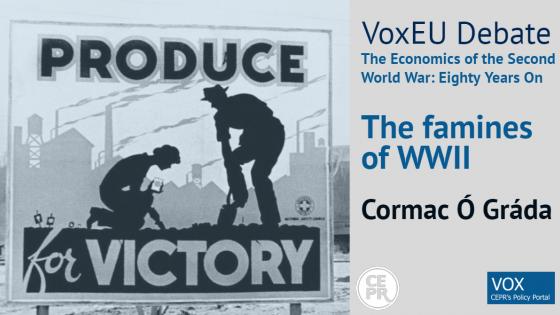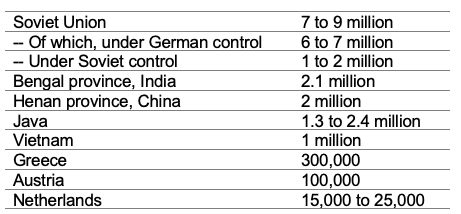This column is a lead commentary in the VoxEU Debate "The Economics of the Second World War: Eighty Years On"
By constraining consumption and restricting the flow of goods, people, and information, wars make famines more likely. During WWII, famine-related deaths matched or outnumbered military losses. While some of the main actors (the UK, the US, Germany, and Japan) escaped famine, the death tolls elsewhere were massive in both absolute and relative terms.
The scale of mortality
Although increases in infant mortality rates, the prevalence of stunting, and deaths from tuberculosis—all clear markers of malnutrition—were widespread, of the warring powers only the Soviet Union suffered mass starvation. More died of famine in occupied Soviet regions than anywhere else. The Nazi Hunger Plan of early 1941, which envisaged the expulsion and starvation of 30 million people out of grain surplus areas, never materialised, but brutal requisitioning in Nazi-occupied areas resulted in about 4 million deaths.
When Soviet POWs are included, about 7 million Soviet citizens perished of starvation and famine in occupied areas (Table 1). Ukraine and Belarus suffered disproportionately, with the former losing over 3 million, or nearly 8% of total population, to famine. At least another 1 million died in the non-occupied Soviet Union, mostly in blockaded Leningrad. Deaths would have been much higher in non-occupied areas but for good harvests, a huge increase in potato cultivation, and Allied food aid (Gerhart 2009, Ellman and Maksudov 1994, Barber and Harrison 1991: 88-89, Vallin et al. 2012: 69, Goldman and Filzer 2015, Collingham 2011: 213-218, Wheatcroft and Ó Gráda 2017).
Table 1 Famine deaths during WWII
Sources: Gerhart (2009), Ellman and Maksudov (1994), Barber and Harrison (1991: 88-89), Vallin et al. (2012: 69), Goldman and Filzer (2015), Collingham (2011: 213-218), Wheatcroft and Ó Gráda (2017). All figures are approximate.
Elsewhere in Europe, Greece was worst affected in relative terms. There, famine followed Nazi occupation and Allied blockade in 1941. Although foreign food aid helped, arriving in neutral Swedish vessels from November 1942, the death toll of about 300,000 still accounted for about 5% of the population (Hionidou 2006: 2).
Famine mortality elsewhere in Europe was lighter. In Austria, about 100,000 (1.5% of the population) perished in 1944-45 (Mitchell 1975: 90). As ‘Aryans’, the Dutch were relatively well treated by their Nazi occupiers until late 1944, when occupying forces in the heavily urbanised western Netherlands responded to a rail strike and associated partisan activity with an embargo on the transport of food supplies. This quickly converted a situation of adequate food supplies to one of severe privation and famine. Estimates of excess mortality during the Hongerwinter range from 15,000 to 25,000 (Ekamper et al. 2017: 114).
In Italy, food consumption fell from a pre-war mean of about 2,600 calories a day to 1,900 calories by 1944; classic famine symptoms may have been absent, but both infant mortality and deaths from infectious and respiratory diseases rose, first in the south, then in the north (Daniele and Ghezzi 2017, League of Nations 1946: 5, Collingham 201: 366).
World War II led to several major famines in Asia. In Java, estimates of excess mortality in 1943-45 range from 1.3 to 2.4 million; the latter estimate would have meant 5.7% of the population (Brennan et al. 2017: 24, van der Eng 2008: 38). In the Chinese province of Henan, drought and war-induced famine killed an estimated 2 million in 1942-43 and forced another 2-3 million to flee, while in Vietnam a combination of poor harvests and war led to one million deaths (Muscolino 2015: 2, Huff 2018, Baker 2018: 94). In both Henan Province and Vietnam, those totals would have represented about 5% of the populations.
For Bengal, the best-guess estimate is 2.1 million (Maharatna 1996: 147), or about 3% of the total population. In Iran, a critical source of oil and a transit route for Soviet supplies, harsh requisitioning measures by occupying British and Soviet troops resulted in disease and famine, although the death toll, though unknown, was probably modest (Bharier 1968: 277). Outside Europe and Japan, where most deaths were directly attributable to starvation, famine victims succumbed mostly to infectious diseases (compare Maharatna 1996: 151-154).
Entitlements and rationing
Food rationing was almost universal during the war. Rations generally reflected some definition of ‘need’, whereby the military and those engaged in heavy labour were granted extra calories and women and children generally were entitled to less; in Britain, invalids were entitled to extra food in exchange for sugar entitlements. The perception that rationing was ‘fair’ probably boosted morale (Johnston 1953: 170, Barber and Harrison 1991: 80).
In Britain, Germany, and Japan, rationing was effective; even though food availability was sharply reduced almost everywhere, few literally died of hunger. Britain and Germany managed to maintain food consumption per capita at about 3,000 calories throughout the war. In Japan consumption fell from a norm of 2,000 calories per capita before Pearl Harbor to 1,900 calories in 1944, plummeting to 1,680 calories by the war’s end. Belgium, the Netherlands, Denmark, Norway, and Finland fared somewhat worse at 2,300-2,800 calories. In France, ineffective rationing under German occupation yielded inadequate calories—an average of 1,180 in 1941-44—with resultant increases in mortality in some areas and widespread resort to black markets (Mouré 2010).
The range and quality of foods available worsened. In Japan, rice available for domestic use dropped from 153 kilograms to 119 kilograms per capita and fish from an average of 63.6 grams per diem in 1939/41 to 31 grams in 1945. Wheat, barley, soybeans, potatoes, and yams were substituted for rice. The lack of fish and fresh fruit and vegetables led to protein and vitamin C and B1 deficiencies; there were significant increases in the incidence of beriberi and tuberculosis, and the physical growth of children was severely constrained (Johnston 1953: 163-164, 268-269, 276, USSBS 1946: 20-21, Kagawa et al. 2011, Aldous 2010). Until very near the end of the war, the authorities managed to maintain a daily ration of 2.3 go (approximately 1.725 cups; 1,158 kcals) for normal consumers, though with an ever-diminishing rice share (Johnston 1953: 202). For much of the war, supplementary rations were available for certain categories of workers, but the deterioration of supplies led to increased reliance on the black market. Still, classic famine symptoms and excess mortality were absent in wartime Japan.
Bacon, butter and sugar were the first food items to be rationed in the UK, starting 8 January 1940; eventually, practically everything but bread and vegetables was rationed. Rationing was by weight except in the case of meat (by price). By contrast, in Greece—where rations were minimal, control of supplies ineffective, and the normal functioning of markets lacking—black markets were ubiquitous. Clothes, household goods, medicinal drugs, and sex were exchanged for food (Hionidou 2004).
Since Sen (1981: 6-8), it has been conventional to distinguish famines arising from a loss of food entitlements amongst the population from those attributable to an absolute shortage of food. Sen’s study of the Bengal famine of 1943-44 was widely recognised as a classic case of starvation amidst sufficiency. It is better seen as a war famine, however.
Perhaps the most convincing evidence against the official claim that there was no decline in food availability is the series of food drives instigated by the government in the fall of 1943, which uncovered virtually no hoarded stocks.
The Moldova famine of 1946-47 has been deemed an intermediate case: food became less available, but more forceful government action would have saved the situation (Ellman 2000, Wheatcroft 2012).
Resilience and repression
Resilience and morale don’t win wars but they clearly matter. The role of resilience is an important theme in the new literature on the Dutch Hongerwinter (de Zwarte 2019) and the Leningrad blockade (Kirschenbaum 2017, Goldman and Filtzer 2018). In unoccupied parts of the Soviet Union, the authorities maintained morale by matching brutality and repression with strenuous and largely successful efforts at feeding the population and keeping infectious diseases at bay; in Leningrad, where massive mortality was unavoidable, major epidemics were prevented (Barber and Harrison 1991: 87-88). In Japan, civilian morale was already at a low ebb and famine imminent when the use of atomic bombs was decided; whether the military would have countenanced surrender otherwise is disputed (USSBS 1947).
The denial of information and of the freedom to move were aggravating factors in wartime famines. Repression in the form of wartime censorship hid the gravity of the situation in distant Bengal in 1943 from the British public, while Stalin’s refusal to reveal the true situation in the Soviet Union in 1945/6 precluded aid from former allies. Another standard famine coping mechanism, migration, was constrained by warfare and wartime restrictions, but it still operated powerfully in Henan province and in Greece (Muscolino 2015, Hionidou 2019).
The shadow of war
It is never over until it is over. Of the plethora of long-run outcomes linked to prenatal exposure to famine during the Dutch Hongerwinter, lower adult body size and higher incidences of diabetes and schizophrenia are the most robust (de Zwarte 2019, Lumey and van Poppel 2013). Stanner and Yudkin (2001) ruled out any link from foetal exposure during the much larger Leningrad blockade of 1941-44 to metabolic or cardiac conditions in adulthood, but Vågerö et al. (2013) found that exposure to the blockade in childhood or adolescence predicted cardiovascular disease (for men), breast cancer (for women), and higher adult blood pressure (for both). Related work on children’s wartime exposure to hunger on adult outcomes, using European survey data, has identified significant costs in terms of other economic and health outcomes (Kesternich et al. 2014).
Finally, the famines that followed in the wake of WWII are part of the reckoning. In February 1946, US President Truman warned of a global famine that “may prove to be the worst in modern times”. One famine cost 100,000 lives in Tokyo in the second half of 1945; another was the Soviet famine of 1946-47. The latter was proportionately most severe in Moldova, where 100,000 or 5% of the population perished, but most costly in numbers of lives in Ukraine (300,000) and elsewhere in the Soviet Union (500,000) (Ellman 2000: 611-617, Vallin et al. 2012: 70). Elsewhere, despite Truman’s warning, malnutrition was widespread but famine was averted (Aldous 2010, Collingham 2011: 467-474).
References
Aldous, C (2010), “Contesting famine: hunger and nutrition in occupied Japan, 1945-1952”, Journal of American-East Asian Relations 17: 230-56.
Baker, M (2018), “The slow, the quick and the dead: Environment, politics and temporality in the Henan Famine, 1942-43”, International Review of Environmental History 4(2): 93-109.
Barber, J, and M Harrison (1991), The Soviet home front 1941-1945, London: Longman.
Brainerd, E (2010), “Reassessing the standard of living in the Soviet Union: an analysis using archival and anthropometric data”, Journal of Economic History 70(1): 83-117.
Brennan, L, L Heathcote and A Lucas (2017), “War and famine around the Indian Ocean during the Second World War”, in M Schwartz, H Harris, and D C Comer (eds.), Ethics in the global south, Bingley, UK: Emerald, pp. 5-70.
Collingham, L (2011), The taste of war: World War Two and the battle for food, London: Allen Lane.
Daniele, V, and R Ghezzi (2017), “The impact of World War II on nutrition and children’s health in Italy”, Investigaciones de Historia Económica - Economic History Research.
de Zwarte, I (2019), De Hongerwinter, Amsterdam: Prometheus (revised version of “The Hunger Winter: Fighting famine in the occupied Netherlands 1944-45”, unpublished PhD dissertation, University of Amsterdam.
Ekamper, P, G Bijwaard, F van Poppel and L H Lumey (2017), “War-related excess mortality in The Netherlands, 1944–45: new estimates of famine- and non-famine-related deaths from national death records”, Historical Methods 50(2): 113-28.
Ellman, M, and S Maksudov (1994), “Soviet deaths in the Great Patriotic War: A note”, Europe-Asia Studies 46: 671-80.
Ellman, M (2000), “The 1947 Soviet famine and the entitlement approach to famines”, Cambridge Journal of Economics 24: 603-30.
Gerhart, G (2009), “Food and genocide: Nazi agrarian politics in the occupied territories of the Soviet Union”, Contemporary European History 18(1): 45-65.
Goldman, W Z, and D Filtzer (eds.) (2015), Food provisioning in the Soviet Union during World War II, Bloomington: Indiana University Press.
Hionidou, V (2004), “Black market, hyperinflation, and hunger: Greece 1941-44.” Food and Foodways 12: 81-106.
Hionidou, V (2006), Famine in wartime Greece, Cambridge: Cambridge University Press.
Hionidou, V (2019), “‘If we hadn’t left … we would have all died’: Escaping famine on the Greek island of Chios, 1941-44”, Journal of Refugee Studies, in press.
Huff, G (2019), “Causes and consequences of the Great Vietnam Famine, 1944–5”, Economic History Review 72(1): 286-316.
Johnston, B F (1953), Japanese food management in World War II, Stanford: Stanford University Press.
Kagawa, M, Y Tahara, K Moji, R Nakao, K Aoyagi, and A P Hills (2011), “Secular changes in growth among Japanese children over 100 years (1900-2000)”, Asia Pacific Journal of Clinical Nutrition 20(2): 180-189.
Kerternich, I, B Siflinger, J P Smith, and J K Winter (2014), “The effects of World War II on economic and health outcomes across Europe”, Review of Economics and Statistics 96(1): 103–118.
Kirschenbaum, L A (2017), “The meaning of resilience: Soviet children in World War II”, Journal of Interdisciplinary History 47(4): 521-35.
League of Nations (1946), Food, famine and relief 1940-46, Geneva: League of Nations.
Lumey, L H, and F W A van Poppel (2013), “The Dutch famine of 1944-45 as a human laboratory: Changes in the early life environment and adult health”, in L H Lumey and A Vaiserman (eds.), Early life nutrition and adult health and development: Lessons from changing dietary patterns, famines and experimental studies, New York: Nova Biomedical, pp. 59-76.
Maharatna, A (1996), The demography of famines: An Indian historical perspective, Delhi: Oxford University Press.
Mouré, K (2010), “Food rationing and the black market in France (1940-1944)”, French History 24(2): 262-82.
Muscolino, M S (2015), The ecology of war in China: Henan Province, the Yellow River and beyond, 1938-1950, Cambridge: Cambridge University Press.
Ó Gráda, C (2009), Famine: A short history, Princeton: Princeton University Press.
Stanner, S A, and J S Yudkin (2001), “Fetal programming and the Leningrad Siege study”, Twin Research 4(5): 287-92.
US Strategic Bombing Survey (USSBS) (1946), Summary report (Pacific War), Washington, DC: Government Printing Office.
US Strategic Bombing Survey (USSBS) (1947), The effects of air attacks on Japanese urban economy, Washington, DC: Government Printing Office.
Vallin, J, F Meslé, S Adamets, and S Pyrozhkov (2012), “The consequences of the WWII and the Stalinist repression”, in F Meslé and J Vallin (eds.), Mortality and causes of death in 20th-century Ukraine, New York: Springer, pp. 39-74.
Vågerö, D, I Koupil, N Parfenova, and P Sparen (2013), “Long-term health consequences following the siege of Leningrad”, in L H Lumey and A Vaiserman (eds.), Early life nutrition and adult health and development: Lessons from changing dietary patterns, famines and experimental studies, New York: Nova Biomedical, pp. 207-226.
van der Eng, P (2008), “Food supply in Java during war and decolonisation, 1940-1950”, MPRA Paper 8852.
Wheatcroft, S (2012), “The Soviet famine of 1946-1947, the weather and human agency in historical perspective”, Europe-Asia Studies 64(6): 987-1005.
Wheatcroft, S G, and C Ó Gráda (2017), “The famines of World Wars I and II”, in G Alfani and C Ó Gráda (eds.), Famine in European history, Cambridge: Cambridge University Press, pp. 240-68.




